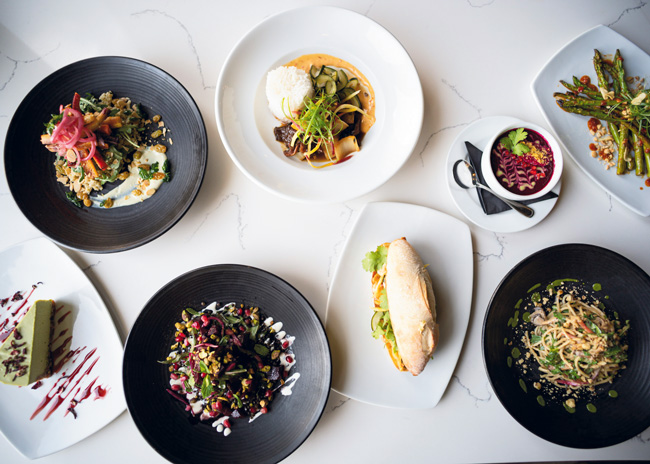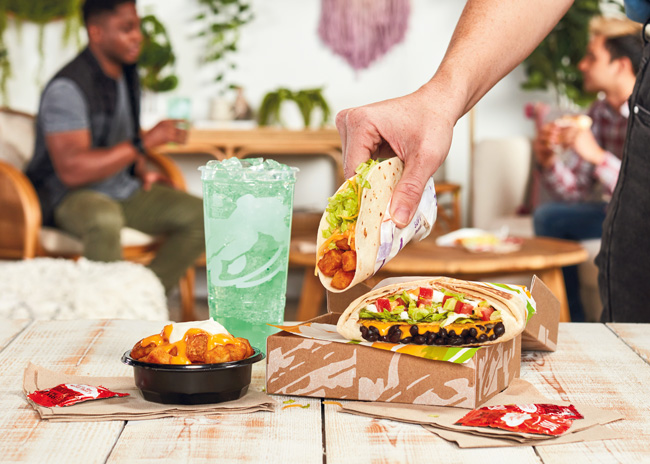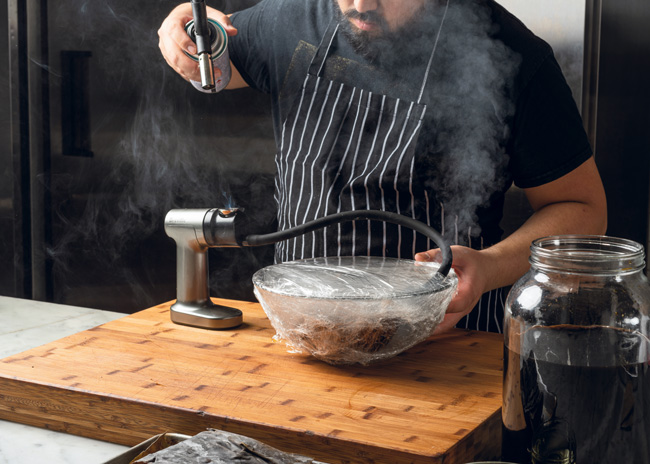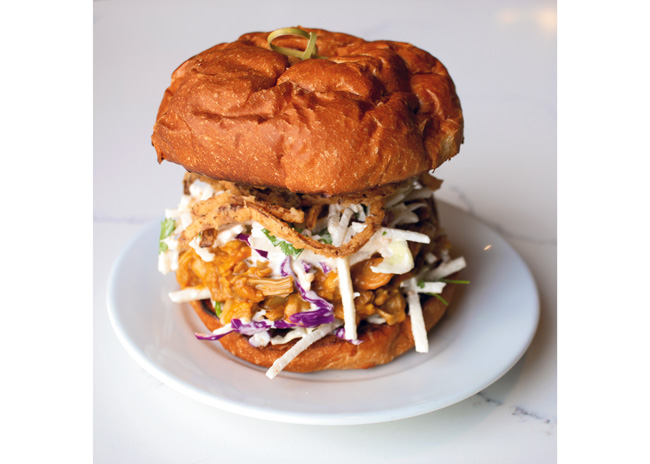With health and sustainability at the forefront, plant-forward concepts and offerings continue to blossom.
 RÜT Bar & KitchenThe plant-forward segment has grown exponentially in recent years, boosted by meatless burgers at quick-serve restaurants like Burger King and Carl’s Jr., an influx of vegan and vegetarian dishes at fast-casual eateries, and meat-free concepts in all types of restaurant segments.
RÜT Bar & KitchenThe plant-forward segment has grown exponentially in recent years, boosted by meatless burgers at quick-serve restaurants like Burger King and Carl’s Jr., an influx of vegan and vegetarian dishes at fast-casual eateries, and meat-free concepts in all types of restaurant segments.
Research from the San Francisco-based Plant Based Food Association (PBFA) and Good Food Institute (GFI) in Washington, D.C., revealed the pandemic played a part in fueling this expansion. The U.S. plant-based food market grew by 27% in 2020 for a total of $7 billion in revenues.
Several of Chicago-based Datassential’s “Chains to Watch” from its April 2021 “Firefly 500+” report are plant-forward concepts, including Chicago’s True Food Kitchen and California’s Mendocino Farms. “Plant-based chain introductions this year have expanded outside of burgers to include various formats like tacos, burritos, bowls, cauliflower wings, chicken sandwiches and pizza,” says Carly Levin, Datassential’s plant-based expert.
Irvine, Calif.-based Taco Bell, which currently has more than 7,000 locations, was an early adopter of plant-forward items. The chain created a partnership with the American Vegetarian Association (AVA) back in 2015. “We’ve never seen vegetarian offerings as just a trend, and we don’t see them as exclusively for vegetarians,” says a Taco Bell spokesperson.
Earlier this year, the chain reintroduced potatoes on its menu, and announced a partnership with Beyond Meat. In April, Taco Bell began testing its plant-based Cravetarian Taco.
 Taco Bell offers a wide range of vegetarian options.
Taco Bell offers a wide range of vegetarian options.
The chain is not alone, as more chefs and foodservice operators are updating menu offerings and recipes to include plant-based proteins. Shipments of plant-based proteins from foodservice distributors to commercial restaurants increased by more than 60% in April 2021 compared with the same month a year ago, according to Port Washington, N.Y.-based The NPD Group. The largest category shipped, plant-based beef analogues, increased pounds shipped by more than 45% in April 2021 compared with 2020 and more than 82% compared with two years ago. Sales of plant-based chicken equivalents grew by more than 82% in April 2021 compared with April 2020 and more than 25% compared with April 2019. A more recent plant-based category, fish, increased shipments by a whopping 181% in April 2021 compared with a year ago, and 78% compared with two years ago, according to NPD. Classic plant-based proteins, including grains, nuts, vegetables, tofu and tempeh, also experienced substantial growth in April of this year.
Why the Shift?
One of the biggest reasons plant-forward dishes and menus have received increased acceptance is the improved quality and flavor of these items. “This food is more palatable for most Americans, and they’re starting to see that the preparation is more focused,” says Darren Tristano, CEO of Chicago-based market research consultancy Foodservice Results. “Where you’re seeing plant-based foods tends to be cafes in more affluent urban and suburban markets with people who are more lifestyle focused.”
The increased demand for and supply of meat substitutes has fueled more operators to jump on board the plant-forward movement. “Plant-based concepts also are adding familiar, traditional items like Buffalo tenders, gyros and meatballs,” Tristano explains. “Hence, diners can get the comfort food they’re craving in a healthier format.”
More often, popular restaurants will reengineer menus to include plant-based dishes. “It has to do with what the customer base wants and figuring out how to sell it to them,” says Brad Barnes, director, consulting, at the Culinary Institute of America (CIA), located in New York City. “We look at the things out there that are always great sellers; whether it’s the handheld sandwiches or burgers; there’s plenty of room for innovation with new dishes.”
This may consist of a sandwich that is 30% meat and 70% plant based substitutes. “I think our current students are positioned to accelerate even more quickly through the foodservice world because they are more open thinkers and more open to nontraditional approaches,” Barnes says.
 Creating plant-forward dishes and ingredients warrants creative equipment and prep in the back of the house at Matthew Kenney’s upscale eateries.
Creating plant-forward dishes and ingredients warrants creative equipment and prep in the back of the house at Matthew Kenney’s upscale eateries.
Matthew Kenney, chef, entrepreneur, author and educator specializing in plant-based cuisine, has founded dozens of vegan restaurants, in addition to Matthew Kenney Cuisine, a plant-based lifestyle company, and Matthew Kenney Culinary, a plant-based-diet education business. He sees the plant-forward segment as completely different than it was even one or two years ago. “I’ve been in this space for 20 years, and now it is very fast moving,” he says. “It is impacting every single level where food is served, whether it be in a restaurant, hospital, school or airport.”
A trifecta that has propelled the meatless movement, Kenney says, includes education, economics and food quality. Education by the media, with articles, studies, news reports and documentaries, has increased awareness about the benefits of plant-based diets. The continued investments in and partnerships with meat substitute companies by chains, venture capitalists, etc., gives the segment increased exposure. Lastly, Kenney believes the quality of these food items is higher, with greater accessibility.
Impact on the Back of the House
Storage, prep and production adjustments may not be significant for concepts with only a few meatless offerings, but for those with 100% meatless menus, it can be significant. “These restaurants will most likely have to carry more perishable items and SKUs, so they’ll require more refrigeration,” Tristano explains. “In terms of preparation, most ovens or flattops can do the job. We also may start seeing a bigger shift toward air frying and away from oil fryers. The flavor won’t be as good, but the consistency will be equal with a healthier result.”
At Kenney’s 40 restaurants, equipment is streamlined to segregate the different offerings. “There is more labor involved as we make our cheese and milk in house,” he says, adding that vegetable-based entrees are “less expensive to produce but more costly from a labor perspective.”
That handcrafted element with plant-forward dishes still exists at Kenney’s quick-service restaurants, but the equipment is akin to a traditional back-of-the-house setup. “The equipment used depends on the concept,” he explains. “For example, we’re opening Plant City X, a vegan burger-and-fries QSR with a drive-thru that includes charbroilers, fryers, refrigeration, ovens and soft-serve machines.”
That equipment lineup is identical to the setup in Kenney’s fast-casual concepts such as Veg’d in Costa Mesa, Calif. His fine-dining restaurants, which includes Chicago’s Althea, expand on that. “Our fine-dining kitchens include dehydrators; jets to emulsify, blend and aerate at the same time; and vacuum packaging machines,” Kenney says. “We’re not relying on dairy and typical emulsifiers, and we have a much larger area geared toward cold prep due to fermentation and making [plant-based] milk and cheese.”
Kenney has explored adding a refrigerated cheese cabinet for dry-aging plant-based cheese and also anticipates that indoor plant growing will become a part of more kitchens in the future. “We will see changes in the next few years in kitchen design and function,” he predicts.
One of Kenney’s biggest fans, Kim Anderson, texted him her business plan and then partnered with him to co-found Plant City, a Providence, R.I., plant-forward food hall concept that opened in June 2019. The aforementioned Plant City X is the quick-service offshoot of this concept slated to open this summer.
The 16,000-square-foot food hall is touted as the “world’s first plant-based vegan food hall and marketplace,” with 12 concepts ranging from burgers to sandwiches to pizza to Mexican fare, in addition to gourmet groceries and grab-and-go items. It also encompasses a coffee bar, bakery, event space, catering operation and educational classes.
“Plant City’s menus, which include build a bowl, a sandwich bar and chickpea dishes, are supported with grills, pasta makers, fryers, a pizza oven imported from Italy and a stovetop,” Anderson says. “On our team, we have line cooks and an entire prep staff who create 60-plus sauces, cheeses and dressings by hand daily. We have a bit higher labor rate than the average restaurant due to the extensive prep involved.”
Along with being 100% plant based, Plant City is palm oil free, certified kosher, 100% compostable and fully wind powered. “Plant based and sustainability go hand in hand,” Anderson says. “It’s about health, the environment, social justice and animal ethics.”
 A barbecue jackfruit sandwich is RÜT Bar & Kitchen’s take on the popular pulled pork meat version.
A barbecue jackfruit sandwich is RÜT Bar & Kitchen’s take on the popular pulled pork meat version.
When RÜT Bar & Kitchen opened in Spokane, Wash., two years ago, it was the only plant-forward restaurant in the area. “People here were hesitant about plant-based eating, so I wanted to create something that had widespread appeal,” says RÜT’s chef Josh Lorenzen, who co-owns the 1,400-square-foot restaurant with Justin Oliveri.
Its menu of traditional pub fare, including burgers, pasta and wings, is all plant-based. Most recently, the restaurant has ventured into more fine-dining dishes with items like spring spaghetti topped with miso brown butter, pickled ramps, cedar-roasted mushrooms, walnuts and arugula. Its bestsellers include Buffalo-style cauliflower wings and a mushroom jalapeño burger.
“Plant-forward used to be just about swapping out ingredients,” Lorenzen says. “Over time, as it has become more mainstream and with new technology, it has included different products, such as plant-based milk and cheese.”
Lorenzen, a 15-year veteran of the restaurant industry, has seen different versions of plant-forward concepts, some that have worked and others that didn’t take off.
However, Lorenzen says plant-forward and meat-based menus share some similar back-of-the-house elements. “We have figured out how to utilize every square inch of our kitchen since storage space for ingredients is a crucial aspect,” he says. “Our line is similar in the sense that we have a flattop, burner and fryer. It’s just more efficient because things cook faster. We’re not braising meat for 3 hours or taking 15 minutes to cook chicken or steak, so I would like to think our speed of service is quicker. We’re also dealing with less grease as a result of not cooking meat, so cleanup is faster and easier.”
Overcoming Challenges
The path to plant forward is not without its challenges.
“It tends to be more expensive, which is counterintuitive because we think of vegetables as being less costly,” Tristano says. “However, companies processing these foods are doing it in a way that is pricey. As an example, people will pay more when purchasing Burger King’s plant-based burger.”
It also can be a balancing act utilizing mainly fresh ingredients that are seasonal in nature. “Concepts going down this path look at seasonal ingredients like vegetables and fruits that can build their way into a menu,” Tristano says. “We have to expect greater supply from agriculture to keep up with demand, so help will be needed on the farming side to keep prices down.”
For the last decade, the supply of plant-forward concepts versus the demand was out of whack, Tristano says, with many fresh-focused restaurants expanding quickly and then closing. “The supply was exceeding the demand, and now it’s catching up, and the market is balanced out,” he says.
In addition, non-meat concepts can struggle with identity crises and having to overcome the stigma of more bland vegan fare. “Guests visualized vegan fare differently than what we are doing,” Kenney says. “It’s about getting people accustomed to eating plant-based as a meal rather than as a side dish.”
With Kenney’s concepts, it also is about the appreciation of vegetables and vegetable proteins that are not processed. And in the kitchen, this means accommodating a more labor-intensive process.
“Culinary chefs are trained, and the techniques, tools and methods are not aligned with plant-based, so there is a bigger learning curve, totally different skill set and different way of thinking,” Kenney says. “One of the things I’m passionate about is culinary education for chefs. The more chefs we train who subscribe to [plant-based menus], the easier it will be to feed the world and inspire others.”
To educate chefs on going meatless, the CIA hosted the Plant Forward Summit and released its second-largest video training series, “The Plant Forward Kitchen.” “We’re using this as a training platform, with Google as our partner, on a global basis,” Barnes says. “That platform will be out there for people to use to adjust their operations [to accommodate more plant-based dishes].”
Obviously, with the perishable nature of plant-based ingredients, shelf life also is an issue. “Although it doesn’t change much with vegan concepts, the big part is staying ahead of it,” Lorenzen says. “However, my biggest challenge was getting over the hump of what I knew or was taught and the fear of people not receiving it well. Early on, I tried to stay away from the word ‘vegan’ and use ‘plant-based,’ but now I wish I wouldn’t have worried so much. It’s still the same preparation concept of figuring out the salt, fat and acid content and getting the texture right. We don’t have to start over because we’re still cooking food with the same variables.”
Although the plant-forward space can seem intimidating and challenging for operators, this movement is just starting to sprout. “Plant-forward is not a trend but rather an evolution,” Kenney says.



